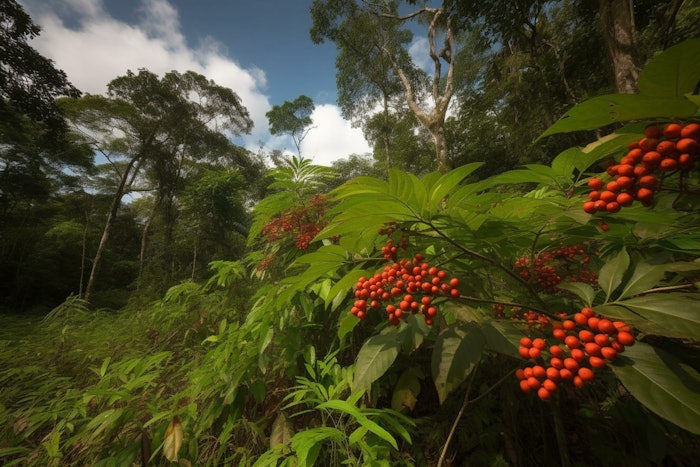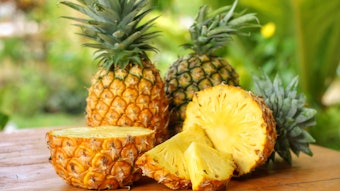
From ancient civilizations to modern-day consumers, people have drawn connections between specific plants and how those botanicals influence the way they feel. Today, the food industry relies on flavors, colors, aromas and more to cue emotional and physical responses from consumers, be it mental clarity, nostalgic comfort or indulgence. With a deep understanding of the various attributes that align with different taste profiles, flavorists can leverage natural extracts–from guarana to ginger and more–to bring forth new innovation opportunities that will delight the senses.
 Marie Wright, president of Creation, Design and Development and chief global flavorist
Marie Wright, president of Creation, Design and Development and chief global flavorist
Guarana (Paullinia cupana (Sapindaceae))
As one of the richest natural sources of caffeine, guarana extract is a prized ingredient in energy drinks and many other beverages. The plant is native to the Amazon basin and is especially common in Brazil, where an incredibly popular soft drink is named after the fruit. The uniquely flavored soft drink brings sharp apple, pineapple and berry notes with citrus undertones. However, the true taste profile of guarana extract is an intense bitterness–like an ultra-dark chocolate bar–with nutty, woody, malty and vegetative notes. This distinction is an interesting example of consumer perceptions of “authenticity.” Today’s shoppers are seeking out sensory experiences that are authentic to their memories and past experiences. So, the refreshing fruit flavors of Brazil’s favorite soft drink may seem more accurate to some than the bitter, astringent taste of guarana extract.
Guarana extract production is labor intensive, as the reddish-orange berries must be harvested manually. The ripe berries partially open to reveal white arils that contain dark black seeds. When the seeds are first extracted, they have a floral note reminiscent of nerolidol (lavender, lily, cedar). The seeds are then concentrated and used as a liquid or dried to a powder. The powders can vary in color, usually shades of light to dark brown. In Brazil, guarana extract must contain at least 1.2% caffeine to comply with beverage legislation. Guarana is a rich source of methylxanthine, which is responsible for its stimulating and cognitive effects, as well as polyphenols such as tannins, catechins, epicatechins and procyanidins B1 and B2.1,2
Yerba mate (Ilex paraguariensis (Aquifoliaceae))
The bioactive properties of yerba mate are key to its association with wellness, including its antioxidant and stimulating effects. Consumers continue to be proactive about their health and well-being and, at this point, functionality is a baseline expectation for many foods and beverages. Flavorists and formulators can use yerba mate to elevate teas, as well as sparkling beverages, and support consumers in their quest to proudly showcase their healthy lifestyles through wellness purchases. The phytochemicals within yerba mate include polyphenolic acids (such as chlorogenic acid), alkaloids (methylxanthines such as caffeine and theobromine) and terpenes (like carotenoids and saponins) in addition to minerals and vitamins.
 Yerba mate is indigenous to Paraguay, Argentina, Brazil, Chile and Uruguay. It has been consumed for centuries as a tea infusion that is traditionally prepared in a dried gourd.Adobe Stock
Yerba mate is indigenous to Paraguay, Argentina, Brazil, Chile and Uruguay. It has been consumed for centuries as a tea infusion that is traditionally prepared in a dried gourd.Adobe Stock
Yerba mate is indigenous to Paraguay, Argentina, Brazil, Chile and Uruguay. It has been consumed for centuries as a tea infusion that is traditionally prepared in a dried gourd. The leaves are blanched, dried and aged, and sometimes dried over wood smoke. Dried leaves are used to make the tea infusion and the extract. Yerba mate has a very distinctive and complex flavor profile. It is bitter, herbaceous, vegetative, often smoky, woody, floral, peppery and even tobacco-like. While plain yerba mate is an acquired taste, it is frequently combined with fruit flavors, like blackberry, peach, grapefruit, lemon, orange or watermelon. Additionally, yerba mate extracts are often incorporated into other types of tea.
Ginger (Zingiber officinale (Zingiberaceae))
Ginger is a common spice consumed worldwide that finds prominence as an excellent “flavor mingler.” Its profile is complex, so the qualities of ginger oils and extracts vary considerably. Some have pronounced fresh lemon, melon and rose notes, some are more herbal, medicinal and earthy, while others are roasted and nutty. Combinations of ginger with lemon, mango, pear and honey are often featured in foods, teas and other beverages.
 Gingerol activates heat receptors on the tongue and is added through an oleoresin.Adobe Stock
Gingerol activates heat receptors on the tongue and is added through an oleoresin.Adobe Stock
Ginger is also known to bring heat. Gingerol activates heat receptors on the tongue and is added through an oleoresin. Major components of ginger oil are zingiberene and ar-curcumene, which contribute peppery, spicy notes. The hot, pungent flavor is an integral element in many Asian cuisines. With the versatility to pair with umami, sour and sweet flavors, spicy ginger applications span curries and kimchi, meat and seafood dishes, fruit preserves, candies, baked goods and numerous beverage formats. Flavorists can leverage ginger to bring new heights of culinary excitement to consumers thirsting for sensorial exploration.
The perceived wellness benefits of ginger are another element of its appeal. Phenolic compounds, including gingerols, shogaols and paradols are associated by consumers with anti-inflammatory activity and gastrointestinal digestive efficiency. Thus, ginger can offer cues of digestive health as another pathway to overall well-being.
Coconut (Cocos nucifera (Arecaceae)
Coconut water has long been a popular drink in tropical regions, and now it is often associated with active nutrition. As a natural source of electrolytes like potassium, sodium, calcium and manganese, coconut water is a refreshing way to aid hydration and replenish the body after physical activity. To some, coconut is the essence of summer. Flavor pairings with pineapple, lychee, banana and mango evoke beach vacations, and juicy citrus fruits are as bright as sunshine. On top of that, coconut offers complexity and a depth of flavor as varied as sweet, fresh, nutty, toasted, creamy and/or milky notes. Because the taste of coconut is so distinct, it is difficult to replicate authentically without using a quality extract.
 Concentrated coconut extracts can also contribute a rich mouthfeel for a multisensorial experience.Adobe Stock
Concentrated coconut extracts can also contribute a rich mouthfeel for a multisensorial experience.Adobe Stock
Concentrated coconut extracts can also contribute a rich mouthfeel for a multisensorial experience. Many consumers are embracing luxuriously indulgent flavors to satisfy their tastebuds and soothe their emotions. Coconut pairs beautifully with sophisticated flavors of vanilla, coffee, hazelnut and chocolate, particularly in dairy foods and beverages, from milk and yogurt to frozen delights. Culinary applications benefit from coconut flavors too, such as spicy curries, smoky meats and savory vegetable stews.
Spotlight on Naturals
Through natural extracts, brands can find new avenues to connect with consumers and meet evolving expectations and demands, from a focus on health to a desire for exploration. It takes a scientific approach to investigate and understand the intricacies of natural extracts. Bringing those complexities to the forefront in food and beverage formulations takes an artful approach to champion distinct flavor profiles, along with other unique benefits from mouthfeel to wellness attributes. Partnering with a global supplier with deep formulation and flavor expertise alongside an extensive ingredient library can unite the art and science needed to inspire innovation with natural extracts across product categories.
References
1ANVISA, Justificativa Limites Suplementos - CP 457-2017.
2Irwin et al. (2018) Curr. Res. Nutr Food Sci Jour., Vol. 6(2) 329-345.










